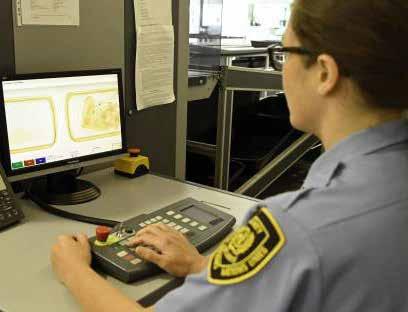
3 minute read
Mass melt A new nuclear application to predict the future of glaciers
By Joanne Burge
Globally, glaciers have been losing mass since the 1970s. The ratio of fresh snowfall to ice melt has been tipped off balance by global warming. These great ice structures are melting, weakening, collapsing and disappearing without precedent around the world. The result is flooding, droughts, threatened water supplies and weakened economies, all contributing to the catastrophic impacts of climate change. With so many lives dependent on glaciers for drinking water, agriculture, hydropower and tourism, accurately predicting and planning for what will happen to them next is critical.
Switzerland relies on its glaciers, but they too are melting fast. According to the Swiss Academy of Sciences, glaciers in the country lost more than six per cent of their volume in 2022, the worst year on record. Researchers say that the Aletsch glacier, the largest in Switzerland, could lose half its ice volume by the end of the century.
Glaciologists traditionally track glacier movement using markers, such as rods, photographs and historical paintings, to compare ice changes over time. Incidental markers, such as crashed aeroplanes, can also signal glacier movement. Now there is another, more precise method, which can help glaciologists more accurately model glaciers’ behaviour and, in turn, predict their future. This can support decision makers in planning for the glaciers’ retreat or total disappearance.
Around 40 kilometres south of the country’s capital, Bern, Spiez Laboratory has developed a nuclear technique based on the signature recorded in ice during the nuclear weapons tests (NWTs) of the 1950s and 1960s. These NWTs generated and released into the atmosphere artificial radionuclides that settled in the surface layers of glaciers around the world. As the dates of these NWTs are known, identifying peak concentrations of these radionuclides, as well as radionuclide dispersion patterns owing to ice flow, can define the ice layers’ chronology.
“We used an existing technique of measuring radionuclides in soils and other solid material and, for this first time, applied this to water, ice and snow,” said Stefan Röllin, a researcher from the Nuclear Chemistry Division at Spiez Laboratory.
Radionuclide detection in ice
In 2019 and 2020, Spiez Laboratory experts and members of the Swiss Armed Forces scaled the Aletsch and Gauli glaciers in the rugged terrain of the Bernese Alps to collect invaluable isotopic data on their ice flows. They extracted around 200 surface ice samples from each glacier, each sample weighing up to 1 kilogram — a large enough quantity to detect the low levels of radionuclides. They then melted the samples and applied radiochemical methods to extract and purify uranium and plutonium isotopes, which they analysed using a highly sensitive instrument called a multicollector inductively coupled plasma mass spectrometer, or MC-ICP-MS.
The researchers also applied other nuclear techniques that can detect the presence of NWT radionuclides in environmental samples, including high resolution gamma ray spectrometry, which detected the presence of caesium, and liquid scintillation counting, which detected the presence of tritium.
“These data can be used to refine and tune glacier flow models, get a better idea of how fast the glacier is melting, predict its future and calibrate ice flow models for greater precision,” said Röllin. The methods developed by Spiez Laboratory were validated against IAEA reference samples of water from the Irish Sea to ensure accuracy. Reference samples are used by scientists to check that their testing methods yield accurate results. The IAEA makes such samples available to laboratories worldwide.
“Our tests against the IAEA reference material confirmed our ability to analyse incredibly low radionuclide concentrations in water — a millionth of a millionth of a millionth of a gram per kilogram
— something that’s quite difficult to do,” said Röllin.
Spiez Laboratory presented its research at the International Conference on Environmental Radioactivity (ENVIRA 2021) in Greece in 2021, and at the International Conference on Radionuclide Metrology — Low Level Radioactivity Measurement Techniques (ICRM–LLRMT), 2022, in Italy.
Spiez Laboratory has been an IAEA Collaborating Centre since 2016 and, in 2020, was re-designated as such until 2025, in order to support the IAEA’s programmatic activities. As an IAEA Collaborating Centre, it provides training for fellows, and hosts training courses and scientific visitors. It also participates in expert missions to IAEA Member States, to promote the practical application of this technique in other places where glaciers are important for sustainable environmental policy and the economy.
“Spiez Laboratory is a centre of excellence which has a track record of outstanding analytical proficiency, and extensive experience with field sampling and measurements of all types of contaminants, in particular radionuclides,” said Iolanda Osvath, Head of the IAEA’s Radiometrics Laboratory. “It provides tremendous support for training and methodological development to the IAEA’s network of Analytical Laboratories for the Measurement of Environmental Radioactivity (ALMERA). Its research and development addresses a broad range of environmental problems with innovative approaches, as its novel work on glaciers demonstrates.”
“Our tests against the IAEA reference material confirmed our ability to analyse incredibly low radionuclide concentrations in water — a millionth of a millionth of a millionth of a gram per kilogram — something that’s quite difficult to do.”
Stefan Röllin, Researcher at Spiez Laboratory’s Nuclear Chemistry Division
“It’s traditional that farmers use nitrogen fertilizers to improve their crops. However, they may be adding more nitrogen than what a plant can absorb. This not only generates extra emissions of nitrous oxide, but also makes the plant less productive and impacts farmers’ income.”
— Mohammed Zaman, FAO/IAEA Soil Scientist






